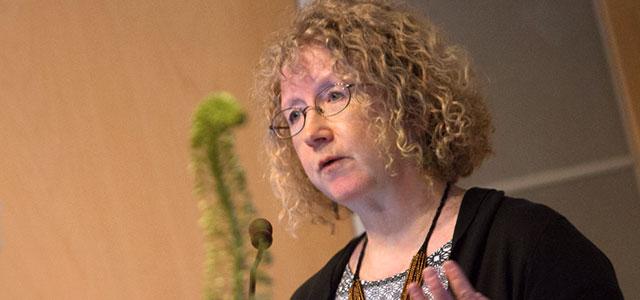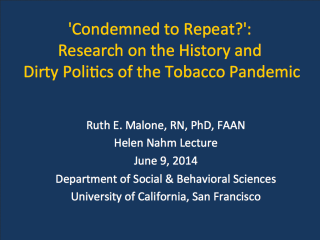
Ruth Malone delivers the 2014 Helen Nahm Research Lecture (photo by Elisabeth Fall).
Reframing the Tobacco Story
On June 9, 2014, Ruth Malone, professor and chair in the Department of Social and Behavioral Sciences – and the Nursing Alumni/Mary Harms Endowed Professor of Nursing and Health Policy – delivered the 34th annual Helen Nahm Research Lecture.
Malone’s work on tobacco control and the behavior of the tobacco industry, especially as it affects marginalized and special populations, has earned her a national and international reputation. She and her team have produced groundbreaking work – supported steadily by, among others, the National Cancer Institute and the National Institute on Drug Abuse – that has influenced policy on corporate social responsibility, “endgame strategies” for tobacco, and voluntary business practices such as retailers choosing to stop selling tobacco.
Malone is also a much-sought-after mentor for doctoral and postdoctoral students as well as junior faculty. Students give her classes extremely high ratings. And she has taken on multiple leadership roles in the School, on campus and in the profession, including serving as editor-in-chief of Tobacco Control, the respected international journal devoted to tobacco control policy issues, and co-founding the nursing advocacy group Nightingales Nurses, which works to educate the public about the role of the tobacco industry in perpetuating the tobacco epidemic.
 Her Nahm lecture, “‘Condemned to Repeat?’: Research on the History and Dirty Politics of the Tobacco Pandemic,” focused on the power of narrative in first creating and now battling the tobacco epidemic, which in the last century has caused some 100 million deaths worldwide.
Her Nahm lecture, “‘Condemned to Repeat?’: Research on the History and Dirty Politics of the Tobacco Pandemic,” focused on the power of narrative in first creating and now battling the tobacco epidemic, which in the last century has caused some 100 million deaths worldwide.
Early Stories
In her talk Malone spoke of how, while growing up, she was exposed to powerful stories the tobacco industry was telling in the media about the social and even health-related benefits of cigarette smoking. She noted that the advent of modern cigarettes – with companies’ seeking a return on their investment in mass production technology – created an “industrially produced epidemic of lung cancer.”
Malone herself was not immune to the messaging, confessing that as a young psychiatric nurse she smoked with her patients, and that later she took smoke breaks while working on cancer wards.
But as the facts about tobacco use began to emerge, Malone did more than quit smoking; she began to think about how “the narrative of cigarette as a normal consumer product was created and sustained” and how she felt a responsibility to deconstruct and reshape that narrative to reflect what her research and the research of others has uncovered. Her focus on effective storytelling found an organizing principle when she was doing a postdoctoral fellowship with Lisa Bero of the UCSF School of Pharmacy.
The Tobacco Papers
“All of a sudden this wealth of internal tobacco company documents was released. As a closet historian, I thought I had died and gone to heaven,” Malone said. The tobacco companies hoped that an arduous process for examining the content of those documents would deter those who wanted to look deeply at them. “But they miscalculated terribly,” said Malone. “My whole research program is thanks to that miscalculation.”
One topic in the documents that jumped out to Malone and her team was the tobacco industry’s efforts to market to the African American community – not just through obvious advertising, but through Big Tobacco insinuating itself into political and media groups in which the African American community places a lot of trust.
The papers ultimately revealed as well that the industry saw numerous “marginalized” groups as growth markets, including the homeless, the mentally ill and the gay community. The tobacco industry employed a number of initiatives to reach out to these groups and hook them on the industry’s products. Malone and her team wrote and published a series of papers that incontrovertibly documented these tactics, which help explain, she said, “the racialized geography of today’s health disparities,” as well as the ways that cultural context can influence how populations perceive a narrative. The latter understanding has helped inform successful tobacco control efforts.
Malone also described how she and her colleagues have examined and published papers about the way Big Tobacco has successfully lobbied to shut down military tobacco control efforts, such as the current secretary of the Navy saying he would like to stop sales of cheap tobacco in military stores. In her talk, Malone noted, “We should provide better stress management [for the military] than this deadly habit.” Malone’s team’s research using the tobacco company documents has demonstrated that every time the military tries to rein in tobacco use, the tobacco industry rallies allies in Congress to thwart those efforts, and noted that the same dynamic may be unfolding again today. “How many times are we going to let the tobacco companies run this same play?” she asked. Are we, as philosopher George Santayana said, “condemned to repeat” the past?
Public Health vs. Big Tobacco
Over time, Malone continued, the tobacco industry has come to view the public health/tobacco control community as its primary competitor and labeled it the ATI, or anti-tobacco industry. Her research uncovered a 20-year plan formulated by the Philip Morris tobacco company to battle the public health community by creating what the industry called “a new foundation of acceptability for their activities,” she said. Part of the plan included creating and exploiting divisions within the tobacco control movement.
This time, however, researchers like Malone and her colleagues are shining a light on these efforts in real time. Her group has published a series of papers that document tobacco companies' reinvention efforts and their failures within a changing social context in which they are increasingly regarded as pariahs. Malone’s group has conducted a review of research on campaigns that seek to “denormalize” the tobacco industry, finding that such denormalization is associated with reductions in tobacco use, decreased intention to smoke and increased desire to quit.
Despite having seen her work used by the World Health Organization, the US Department of Justice, community and health departments and others in policy and advocacy efforts, Malone warned that the work is far from complete, since tobacco is still sold on nearly every street corner.
Consequently, she said, “We need a different narrative.” Her newest initiative centers on developing the dialogue on “the tobacco endgame, because we can’t have another century of this slaughter.” While everyone wants to end the death and disease associated with tobacco, Malone and her team want to understand and address the underlying political and social dynamics that keep the epidemic going. Now that we have dramatically restricted the use of products like lead paint and asbestos, it ought to be possible, Malone argued, to eventually phase out cigarettes.
“Every single thing that has ever been tried in tobacco control began with someone saying ‘you can’t possibly do that,’” concluded Malone, pointing to such efforts as establishing no-smoking sections in restaurants, banning smoking on airplanes and creating smoke-free public places. Citing various studies that have found widespread public support for ending or greatly restricting cigarette sales, Malone will now make a major push to advance discussions around the world about how to write what she hopes will be cigarettes’ final chapter.



